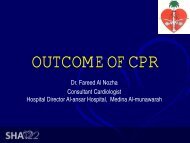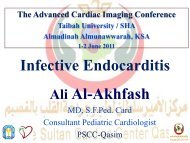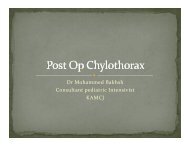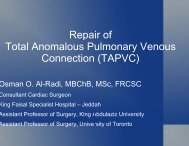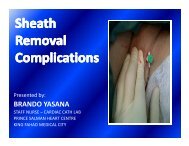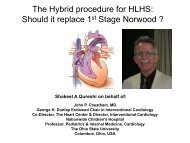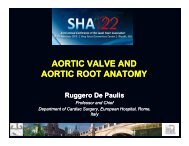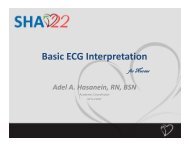Cardiopulmonary Bypass in infants and children - Sha-conferences ...
Cardiopulmonary Bypass in infants and children - Sha-conferences ...
Cardiopulmonary Bypass in infants and children - Sha-conferences ...
You also want an ePaper? Increase the reach of your titles
YUMPU automatically turns print PDFs into web optimized ePapers that Google loves.
<strong>Cardiopulmonary</strong> <strong>Bypass</strong> <strong>in</strong><br />
<strong>in</strong>fants <strong>and</strong> <strong>children</strong><br />
The impact of prim<strong>in</strong>g solutions <strong>and</strong><br />
volumes<br />
Helen Holtby MB BS FRCPC<br />
Helen Holtby MB, BS FRCPC<br />
Hospital for Sick Children Toronto
The Ideal <strong>Cardiopulmonary</strong> <strong>Bypass</strong> Prime …<br />
<br />
<br />
<br />
<br />
Would be physiologic<br />
<br />
mild hypocalcemia<br />
Would not trigger:<br />
<strong>in</strong>flammation<br />
immune response<br />
Would prevent macro or microthrombosis<br />
Would protect end-organ function
Prime volumes <strong>in</strong> Pediatric Patients<br />
• Start at about 200-300ml generally<br />
• Circulat<strong>in</strong>g volume of neonates is 80ml/kg (240ml)<br />
• Dilution of RBC, platelets, coagulation factors<br />
• Dilution of plasma prote<strong>in</strong>s, drug levels<br />
• Significant electrolyte changes
Realistic Prime Solutions<br />
• At least physiologic:<br />
• Blood Prime:<br />
• Age of blood<br />
• Impact of Red Cell transfusions<br />
• Hematocrit values<br />
• Crystalloid/colloid Solutions:<br />
• Colloid osmotic pressure <strong>and</strong> outcomes<br />
• Small volume circuits
Blood Products <strong>and</strong><br />
<strong>Cardiopulmonary</strong> <strong>Bypass</strong><br />
• Age of RBCs <strong>and</strong> outcomes<br />
• Use of whole blood vs component products<br />
• Target hematocrit<br />
• Dilutional l Coagulopathy<br />
• Metabolic Consequences
Age of RBCs <strong>and</strong> Cl<strong>in</strong>ical Effects<br />
<strong>in</strong> Pediatric i Patients<br />
t<br />
• Keidan I,et al . The metabolic effects of fresh versus old stored<br />
blood <strong>in</strong> the prim<strong>in</strong>g of cardiopulmonary bypass solution for pediatric<br />
patients. J Thorac Cardiovasc Surg. 2004 Apr;127(4):949-52.<br />
• Schroeder TH, Hansen M. Effects of fresh versus old stored blood <strong>in</strong><br />
the prim<strong>in</strong>g solution on whole blood lactate levels dur<strong>in</strong>g paediatric<br />
cardiac surgery. Perfusion. 2005 Jan;20(1):17-9.<br />
• Gruenwald CE,et al. Reconstituted fresh whole blood improves<br />
cl<strong>in</strong>ical outcomes compared with stored component blood therapy<br />
for neonates undergo<strong>in</strong>g cardiopulmonary bypass for cardiac surgery:<br />
a r<strong>and</strong>omized controlled trial. J Thorac Cardiovasc Surg. 2008<br />
Dec;136(6):1442-9.<br />
• Ranucci M, et al. Duration of red blood cell storage <strong>and</strong> outcomes <strong>in</strong><br />
pediatric cardiac surgery: an association found for pump prime<br />
blood. Crit Care. 2009;13(6):R207. Epub 2009 Dec 21.
Studies of Blood Products,Bleed<strong>in</strong>g <strong>and</strong><br />
Outcomes Are Confounded By:<br />
• Storage Solutions<br />
• Leucocyte Depletion<br />
• Legislation<br />
• Transfusion Protocols <strong>and</strong> adherence<br />
• Surrogate end po<strong>in</strong>ts <strong>and</strong> relevant f<strong>in</strong>d<strong>in</strong>gs<br />
• Lactate dur<strong>in</strong>g CPB<br />
• Def<strong>in</strong>ition of old vs new
Reconstituted Fresh Whole Blood vs Stored<br />
Blood Component Therapy for Neonates<br />
Undergo<strong>in</strong>g Cardiac Surgery<br />
Study Design<br />
♥ s<strong>in</strong>gle center, prospective RCT<br />
♥ Entrance criteria :<br />
• neonates less than one month of age undergo<strong>in</strong>g CPB for elective open<br />
heart surgery<br />
♥ Exclusion criteria:<br />
• emergency surgery<br />
• known pre-exist<strong>in</strong>g coagulopathy
Study Protocol<br />
Treatment Group<br />
Reconstituted Fresh Whole Blood<br />
(RFWB)<br />
Control Group<br />
Component Blood<br />
Therapy<br />
CPB Prime<br />
• RFWB to achieve<br />
HCT 22-24% on CPB<br />
• RBC to achieve<br />
HCT 22-24% on CPB<br />
Dur<strong>in</strong>g CPB<br />
• RFWB to achieve<br />
HCT >28% prior to term<strong>in</strong>ation<br />
i<br />
of CPB<br />
• 1 unit FFP prior to cross<br />
clamp removal<br />
• RBC to achieve<br />
HCT >28% prior to<br />
term<strong>in</strong>ation of CPB
Conclusions<br />
RFWB is associated with improved cl<strong>in</strong>ical outcomes:<br />
reduced d d chest tube loss at 24 hours <strong>in</strong> CCCU<br />
reduced markers of systemic <strong>in</strong>flammation<br />
reduced ventilation time<br />
reduced <strong>in</strong>otropic support at 24 hours<br />
reduced hospital LOS<br />
It is unclear if this is a result of age of product or<br />
donor exposures or both or someth<strong>in</strong>g else entirely!
Independent effect on post-operative operative outcomes<br />
Chest tube loss 24 hours<br />
Lower platelet count), p
Outcomes <strong>and</strong> Storage of RBCs<br />
• Retrospective review of 192 <strong>children</strong><br />
• Centrifugal pump<br />
• Older blood >4 days<br />
• Results<br />
• Risk of major morbidity only if blood prime<br />
• Increased risk of postoperative complications<br />
• Pulmonary<br />
• Renal<br />
Ranucci M, et al.
Hemostatic Consequences of<br />
Blood Prime<br />
• 30 patients
Results<br />
• No difference between whole blood <strong>and</strong> component<br />
therapy<br />
• Significant thrombocytopenia<br />
• Significant reduction <strong>in</strong>:<br />
• Fibr<strong>in</strong>ogen<br />
• AT III<br />
• Plasm<strong>in</strong>ogen<br />
• II, V, VII, VIII, X<br />
Fibr<strong>in</strong>ogen
Maybe Fresh Whole Blood<br />
• Less <strong>in</strong>flammation i <strong>and</strong> less bleed<strong>in</strong>g<br />
• 200 patients
Results<br />
• Fresh whole blood has no advantage over component<br />
therapy<br />
• In fact…<br />
• Increased LOS <strong>in</strong> CCU<br />
• Increased perioperative fluid overload<br />
• Fewer (by one!) donor exposures
Maybe No Blood<br />
• Limits i of hemodilution<br />
i • Hematocrit<br />
• Dilutional Coagulopathy<br />
• Thrombocytopenia
Hematocrit<br />
• Newburger JW, et al. R<strong>and</strong>omized trial of hematocrit 25%<br />
versus 35% dur<strong>in</strong>g hypothermic cardiopulmonary bypass <strong>in</strong><br />
<strong>in</strong>fant heart surgery. J Thorac Cardiovasc Surg. 2008<br />
Feb;135(2):347-54, 354.e1-4.<br />
No difference between Hct 25% <strong>and</strong> 35%<br />
• Wypij D, et al.J Thorac Cardiovasc Surg. 2008 Feb;135(2):347-<br />
54, 354.e1-4. A hematocrit level at the onset of low-flow<br />
cardiopulmonary bypass of approximately 24% or higher is<br />
associated with higher Psychomotor Development Index<br />
scores <strong>and</strong> reduced lactate levels…..<br />
This study cannot ascerta<strong>in</strong> a universally "safe” hemodilution.
Asangu<strong>in</strong>ous Prime<br />
• Is Beneficial fiil • Is Ahi Achievable<br />
• Less <strong>in</strong>flammation<br />
• Less blood transfusion<br />
• Similar outcomes<br />
• 120-200mL<br />
• Increased complexity<br />
• New oxygenators/filters<br />
• Remote pump<br />
Koster A, et al A new m<strong>in</strong>iaturized cardiopulmonary bypass system reduces transfusion<br />
requirements….<br />
J Thorac Cardiovasc Surg. 2009 Jun;137(6):1565-8. Epub 2008 Aug 16.<br />
Miyaji K, et al. The <strong>in</strong>fluences of red blood cell transfusion on perioperative <strong>in</strong>flammatory<br />
responses…<br />
Int Heart J. 2009 Sep;50(5):581-9.<br />
Golab HD, Bogers JJ. Small, smaller, smallest….<br />
Perfusion. 2009 Jul;24(4):239-42. Epub 2009 Oct 20.<br />
Dur<strong>and</strong>y Y. The impact of vacuum-assisted venous dra<strong>in</strong>age <strong>and</strong> m<strong>in</strong>iaturized bypass circuits…<br />
ASAIO J. 2009 Jan-Feb;55(1):117-20.
No Transfusion<br />
• Not often….it is heart surgery after all!!<br />
• 13 neonates 1.7-4kg<br />
• 11/13 transfused but only 2/13 given platelets<br />
Koster et al JTCVS<br />
2009 137(6):1565-8.<br />
• Delayed RBC transfusion reduces <strong>in</strong>flammatory markers<br />
• CRP<br />
• Neutrophils<br />
• Body water ga<strong>in</strong> Myaji et al, Int Heart J.<br />
2009 50(5):581-9.
No Intra-operative ti transfusion:<br />
• Prime volume 110mL<br />
• VAD<br />
• Acceptable Hgb 7g/dL dur<strong>in</strong>g CPB<br />
• NIRS<br />
• 6/13 neonates had no perioperative transfusion<br />
• All corrective procedures (TGA, HAA, IAA, TAPVD)<br />
Koster et al JTCVS 2009 137(6):1565-8.<br />
1565
Delayed Transfusion<br />
• 54 patients 4-10kg<br />
• 41% received RBC transfusion (leucocyte depleted)<br />
• Weight<br />
• CPB time<br />
• NIRS <strong>and</strong> rSO2 <strong>and</strong> SVO2 plus lactate<br />
t<br />
• No platelets or FFP adm<strong>in</strong>istered<br />
• Elevated cRP <strong>and</strong> WCC <strong>in</strong> patients transfused on bypass<br />
Myaji et al. (Int Heart J 2009; 50: 581-589) 589)
Asangu<strong>in</strong>ous Prime<br />
• Composition<br />
i<br />
• Crystalloid Prime<br />
• What solution<br />
• Colloid<br />
• Album<strong>in</strong><br />
• Starch
Hypertonic Hyperoncotic Solutions<br />
Improve Cardiac Function<br />
• Post CPB s<strong>in</strong>gle <strong>in</strong>fusion i of 6% HES vs 0.9%NaCl 4ml/kg<br />
• Increased CI<br />
• Decreased SVRI<br />
• Decreased extravascular lung water<br />
Pediatrics. 2006 Jul;118(1):e76-84. Epub 2006 Jun 2.<br />
Schroth M, et al
High Colloid Pressure is helpful<br />
dur<strong>in</strong>g CPB<br />
• 25% album<strong>in</strong> vs FFP<br />
• Improved hemofiltration rates<br />
• Decreased weight ga<strong>in</strong><br />
• Comparable effects on renal function
Loeffelbe<strong>in</strong> F. et al.; Eur J Cardiothorac Surg 2008;34:648-652<br />
652
In Summary<br />
• <strong>Cardiopulmonary</strong> prime solutions are partly driven by<br />
technological limitations.<br />
• The ideal CPB prime is probably an<br />
• asangu<strong>in</strong>ous<br />
• low volume<br />
• high colloid osmotic pressure solution<br />
• The freshest blood possible should be acquired
Look<strong>in</strong>g <strong>in</strong>to the far() distance…<br />
Therapeutic qu<strong>and</strong>aries:<br />
RIPC<br />
Superhydrophobic surfaces<br />
Bonded circuits<br />
Endothelium



